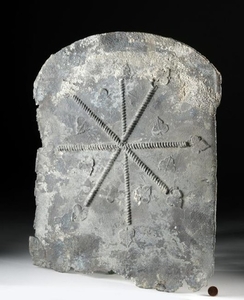Roman Lead Sarcophagus End Panel - Clover Leaves
Roman, Imperial Period, ca. 2nd century CE. The end panel of a lead sarcophagus, its surface divided into eighths by a rope-like motif, each rope terminating in a clover leaf shape. Further three-leafed clover motifs are between each rope. Prior to the 2nd century, Romans cremated their dead; around that time, inspired by the Greek and Etruscan practice of using sarcophagi, they began to place their dead in sarcophagi. This trend spread rapidly throughout the Roman Empire. In the western part of the Empire, which (based on the leaf motif) this panel probably came from, sarcophagi were placed inside a mausoleum against a wall or in a niche, so the only decorated panels were on the front and the short sides. The floral motif refers to actual garlands and flowers used to decorate tombs and altars. This panel protected the grave of a high-status Roman citizen. Size: 15.6" W x 19" H (39.6 cm x 48.3 cm)
Provenance: private Dallas, Texas, USA collection
All items legal to buy/sell under U.S. Statute covering cultural patrimony Code 2600, CHAPTER 14, and are guaranteed to be as described or your money back.
A Certificate of Authenticity will accompany all winning bids.
We ship worldwide to most countries and handle all shipping in-house for your convenience.
#146672
Condition Report: The lower end is bent and the edge is ragged. Small losses from the other edges, but overall in very nice condition. Stamped motifs are very clear. Light deposits on surface.
View it on
Sale price
Estimate
Time, Location
Auction House
Roman, Imperial Period, ca. 2nd century CE. The end panel of a lead sarcophagus, its surface divided into eighths by a rope-like motif, each rope terminating in a clover leaf shape. Further three-leafed clover motifs are between each rope. Prior to the 2nd century, Romans cremated their dead; around that time, inspired by the Greek and Etruscan practice of using sarcophagi, they began to place their dead in sarcophagi. This trend spread rapidly throughout the Roman Empire. In the western part of the Empire, which (based on the leaf motif) this panel probably came from, sarcophagi were placed inside a mausoleum against a wall or in a niche, so the only decorated panels were on the front and the short sides. The floral motif refers to actual garlands and flowers used to decorate tombs and altars. This panel protected the grave of a high-status Roman citizen. Size: 15.6" W x 19" H (39.6 cm x 48.3 cm)
Provenance: private Dallas, Texas, USA collection
All items legal to buy/sell under U.S. Statute covering cultural patrimony Code 2600, CHAPTER 14, and are guaranteed to be as described or your money back.
A Certificate of Authenticity will accompany all winning bids.
We ship worldwide to most countries and handle all shipping in-house for your convenience.
#146672
Condition Report: The lower end is bent and the edge is ragged. Small losses from the other edges, but overall in very nice condition. Stamped motifs are very clear. Light deposits on surface.



